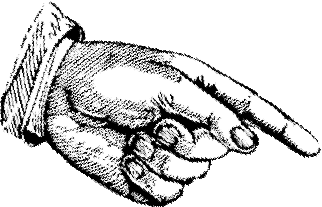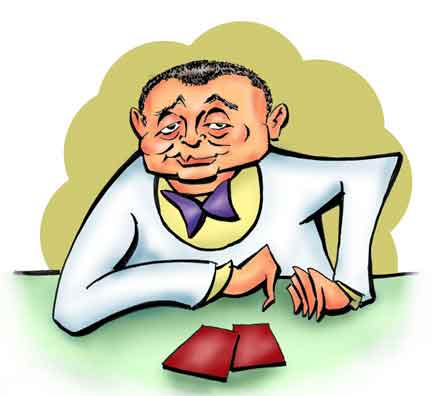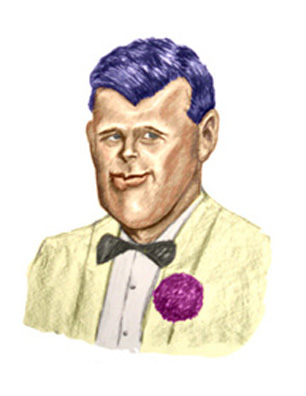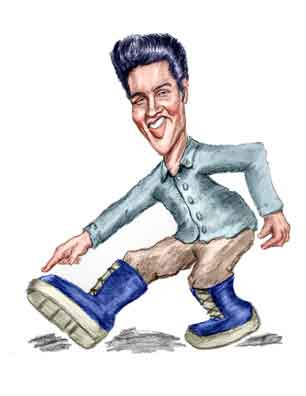007, Auric Goldfinger,
and Miss Galore

(Click to Zoom In)
After more than half a century, many cinematic connoisseurs still consider the film Goldfinger to be the epitome of the Bondian cycle. There was action - but not as overly-choreographed ennui-inducing chase scenes and drawnout eye-staring static confrontations. There were gadgets but not so many or outlandish that the entire faculty of MIT couldn't have envisioned them. But best of all there was plenty of witty repartee twixt Bond and the villain of villains Auric Goldfinger.
| Bond: | "Do you expect me to talk?" |
| Goldfinger: | "No, Mr. Bond, I expect you to die!" |
That said, there are considerable differences between the action of the movie released in 1964 and that in the novel published in 1959. For one thing by looking at photographs from the film, you can see that Gert Frobe1 - who played Goldfinger - was only an inch or two shorter than Sean Connery who the sources universally cite as reaching 6'2".
Footnote
"Frobe" is an Anglicization of the German name, Fröbe, with an umlaut. The English version is sometimes pronounced to rhyme with "globe" while those striving for more linguistic accuracy say FROH-buh.
But the umlauted ö has a bit of an "ur" sound as in "burn" but without the rhotic r. One German professor said to pronounce the sound say long English e - that is ee as in "feet" - but purse your lips as in saying o as in "oh".
As an aside if you're ever taking a music course and you play something by George Frederick Handel, the teacher may get snooty if you pronounce the name like English "handle" where the first syllable is pronounced like "hand". Instead, they'll say the name should be HAHN-del where the a is pronounced "ah".
However, you can - politely, of course - point out that in German the name is properly spelled Händel and has a umlaut in the a. Again English guidelines vary a bit. But it's accurate enough to say that ä is pronounced like short a as in "bat", although it's probably better to think of it as the a sound in "air". But in any case the HĂND-del pronunciation is closer to the correct German than HAHN-del.
But in the book, we get the following description:
Goldfinger was short, not more than five feet tall, and on top of the thick body and blunt, peasant legs was set, almost directly into the shoulders, a huge and it seemed exactly round head. It was as if Goldfinger had been put together with bits of other people's bodies.
But one of the biggest aberrances - and which has been increasingly pointed out - was that the Bond of the book had less than 21st Century standards of tolerance and respect for those who are different. After he met Goldfinger, Bond mused on his new acquaintance.
Bond always mistrusted short men. They grew up from childhood with an inferiority complex. All their lives they would strive to be big - bigger than the others who had teased them as a child ... It was the short men that caused all the trouble in the world.
And that's James being nice!
Also the book and the movie start off on decidedly different feet. The picture begins with James rising from the water. No, not like Venus from the waves but wearing a wetsuit with a waterlogged stuffed duck sitting on the top of his hood.2 He then plants a bomb in an illegal drug lab concealed in a phony oil tank. The work completed, Bond then doffs his wet suit3 to reveal he's dressed in an elegant suit with white tuxedo jacket.
Footnote
Why Bond would be keeping himself out of sight by swimming underwater but having a stuffed duck on his head sticking out on the surface that anyone can see is one of the illogical plot points that crop up in the Bond stories. More on the books' - and movies' - discrepancies later.
Footnote
The "wetsuit" that Bond takes off was actually made out of nylon. A real rubber suit would have been to too tight for the dress clothes underneath to remain properly styled and would have been difficult for Bond to easily doff for the scene.
Next James goes into a nightclub where he nonchalantly checks his watch as the bomb goes off. He comments to his contact who is sitting at the bar.
"At least they won't be using heroin-flavored bananas to finance revolutions."
Then after the impressive explosion - which in those pre-digital days was put on film using an optical printer - Bond keeps a rendezvous with the nightclub dancer who is actually in cahoots with a Mexican killer-for-hire - who according to the book was called a capungo.4
Footnote
The etymology of the word capungo - which Bond tells us is a hired killer who will work for as little as forty pesos or 25 shillings - is obscure. Even native Spanish speakers scratch their head and wonder where the word comes from. To get around the issue in the movie the name appears to be intended as a proper Spanish surname and the actor playing Capungo was stuntman Alf Joint.
However, one Bond scholar found there is a word kapiangu which is a word from a Brazilian Portuguese dialect which means something like "thief". However, using a popular search algorithm of published texts shows the first occurrence of the spelling capungo was from 1959, the date of the novel's publication. Certainly references from the pre-electronic era seem elusive.
But in her room Bond sees the capungo sneaking up behind by the reflection in the girl's eyes. He then swings her around and she gets whacked on the head rather than Bond. Bond then tosses the capungo into the bathtub filled with water and throws an electric sunlamp in after him. Naturally the capungo gets fried and as Bond walks out he says with a typical Bondian quip, "Shocking! Positively shocking!" while the girl comes to.
And in the book? Well, it starts out:
James Bond, with two double bourbons inside him, sat in the final departure lounge of Miami Airport and thought about life and death.
The reader then spends the entire chapter with Bond reminiscing about his last case which has at least some points of similarity to the opening sub-story of the movie. Although Bond didn't have a get-together with a lady, he does have a fight with the capungo in an alley. Of course, Bond wins using a "parry defense against underhand thrust".
Nevertheless compared to later movies, Goldfinger keeps pretty close to the book.5 But even when the novelistic plot points are retained, there are alterations when incorporated into the movie. For instance, in the novel Goldfinger's Korean bowler flinging henchman, Oddjob, meets his end like Goldfinger does in the movie - by going out of the window of a jet whose cabin has been depressurized. In the book Goldfinger meets his end more simply - literally - at the hands of Bond.
Footnote
The next movie Thunderball also keeps close to the book in its action. It was the following picture Diamonds Are Forever where the screenwriter, Tom Mankiewicz, was given full reign to let his imagination run free, which he did.
It's also in Diamonds Are Forever (the motion picture) that Bond quits smoking.
In the movie Bond is reasonably temperate having a nip now and then but never in excess. But in the novel Bond really knocks backs the drinks. In one evening (described in the first two chapters) he has four double bourbons, two double vodka martinis, and a pint of pink champagne. So in one night James has 50% more alcohol than the current recommendation for a single week.
Which brings us to Bond's preferred modus bibentis.
Everyone knows that Bond's favorite drink is a vodka martini, shaken not stirred. Like most of Bond's preferences, this preparation was also the choice of Bond's creator, Ian Fleming. Ian, we read, felt that stirring tended to "bruise" the liquor.

Ian Fleming
Shaken, Not Stirred
We first read of how Bond preferred to shake, not stir, in Ian's debut novel, Casino Royale, published in 1953. Before Bond's game of baccarat with Le Chiffre, he instructs the barman how to make the perfect martini:
"Three measures of Gordon's, one of vodka,6 half a measure of Kina Lillet [a fortified wine used in place or vermouth]. Shake it very well until it's ice-cold, then add a large thin slice of lemon-peel."
Footnote
Yes, the martini contains both gin and vodka!
Since James was in France the bartender's "measure" was probably metric, or 25 milliliters. Also the "proof" of the gin and vodka was probably 80 to 90 or 40% to 45% and the Kina Lillett probably 14% alcohol. So in his drink Bond has about 1.5 ounces of alcohol. That's pretty much a "standard" cocktail.
When the martini came Bond took a sip.
"Excellent," he said to the barman, "but if you can get a vodka made with grain instead of potatoes, you will find it still better."
"Mais n'enculons pas des mouches," he added in an aside to the barman. The barman grinned.
Then Bond turned to his friend, the American CIA agent, Felix Leiter.
"That's a vulgar way of saying 'we won't split hairs'," explained Bond.7
Note that James doesn't say "shaken not stirred". But when he said "shake it very well", we presume he doesn't mean "shake it very well and then stir it, please."
Is there an advantage to the shaken martini vs. the stirred? Well, some experts say no, and in fact, they claim the best martinis are stirred, not shaken. However, the reasoning offered seems to suggest a shaken beverage would be at least equivalent in potable gratification.
Vigorous mixing of a martini, whether shaking or stirring, will do two things. First, it quickly lowers the temperature of the drink. A strong martini can be 30% alcohol by volume (ABV). Ideally this could drop the freezing point to as low as 5 degrees Fahrenheit.
However, actual tests with mixing ice with mixtures of ethyl alcohol and water have demonstrated that the temperature will likely stay above 28 degrees. In actual practice when mixing a real martini, you'll probably have a liquid temperature of around 35 degrees. On the other hand, small bits of ice will float on the surface of the liquid and so when they reach the mouth they will begin to melt, giving a feeling of additional cooling. So a well mixed martini will be - as Bond says he liked them - very cold.
Secondly, the mixing melts the ice which dilutes the alcohol content. This lessens the "bite" of the alcohol. The extra water also forces more of the essential oils that are present in the gin and vermouth into the vapor. This enhances the aromatic flavors (which are actually odors). So a well-mixed martini is a more flavorful and less harsh potation than one unmixed and unchilled.
Martinis, although not completely absent, play less a part in the next novel Live and Let Die. When Bond meets Felix at his hotel, Felix mixes some martinis but how isn't specified. Then before they head uptown to Harlem, they have a couple of martinis but again no mention of the method of agitation. It's only when he's on the way to Florida that Solitaire brings in two glasses along with a cocktail shaker. Then in the third book, Moonraker, there is a comment about the drinks being prepared with a "frosted" cocktail shaker.
Finally in the fourth book Diamonds are Forever (published in 1956) we read that Bond is on record excluding the stirring. That's when he and Tiffany Case are having dinner in New York:
The waiter brought the Martinis, shaken and not stirred, as Bond had stipulated.
But 007 fans have to wait until 1958 with the publication of the sixth novel, Dr. No, to read Bond being quoted directly. When he and Honeychile Rider are having dinner with Dr. No, Honeychile asks for a Coca-Cola. Then Bond puts in his request:
"And I would like a medium Vodka dry Martini - with a slice of lemon peel. Shaken and not stirred, please. I would prefer Russian or Polish vodka."
Note that we read the martini is to be "shaken and not stirred" instead of "shaken, not stirred".
To get to the true quotation, we must move to the first full length motion picture which was also Dr. No. But not right away. When Bond gets to Jamaica, he has the room service waiter whip him up a drink.
"One medium dry vodka martini. Mixed like you said, sir, and not stirred".
It's only toward the end of the movie that we finally hear the proper direction. The irony is it's not from James! When Bond and Honey (played by Ursula Andress) meet Dr. No, he has drinks at the ready.
| Dr. No: | "A medium dry martini, lemon peel, shaken, not stirred." |
| Bond: | " Vodka?" |
| Dr. No: | "Of course." |
Then at long last with the release of the film Goldfinger in 1964 - more than a decade after Casino Royale was published - that Bond himself stipulates his preferred potation with the iconic pithiness. After convincing Goldfinger not to split him in half with a laser beam, Bond is anesthetized and wakes to find himself on Goldfinger's plane. The stewardess, Mei-Lei, walks up.
| Mei Lei: | "Can I do something for you, Mr Bond?" |
| Bond: | "Just a drink. A martini, shaken not stirred." |
To date there have been twenty-eight depictions of James Bond for the viewing audiences. Twenty-five have been produced by EON productions. But there was also a 1967 "spoof" of Casino Royale produced by Columbia and starring David Niven, Peter Sellers, Woody Allen, and a cast of dozens. Despite its initial box-office success, it has not fared particularly well with the critics.
But in a long forgotten production there was also a television version of Casino Royale shown in 1954 which was the first depiction of James Bond on a screen of any size. Here Barry Nelson plays "Jimmy" Bond, an 
 secret agent. Peter Lorre plays Le Chiffre and Linda Christian is the first Bond girl Valerie Mathis. Finally helping "Jimmy" out is Clarence Leiter of the
secret agent. Peter Lorre plays Le Chiffre and Linda Christian is the first Bond girl Valerie Mathis. Finally helping "Jimmy" out is Clarence Leiter of the 
 Secret Service. Despite the changes and that it was being produced when television was still in its infancy, it's not a bad show.
Secret Service. Despite the changes and that it was being produced when television was still in its infancy, it's not a bad show.

Le Chiffre
(Pst! It's Peter)

"Jimmy" Bond
(Barry)
If nothing else the movies have created a "Bondian Universe" where students - whether cinematic or literary - can debate the details and try to sort out various contradictions just as professors do when analyzing the history of the real world. Fortunately, in both the novels and films there's plenty to keep the scholars occupied.
One of the most debatable of topics is the nature and extent of Felix Leiter's wounds - much as the fans of Sherlock Holmes have argued over exactly where Dr. Watson was struck by the Jezail bullet. For those who haven't read Live and Let Die at one point the bad guys throw Felix into a tank of water with man-eating sharks. When he is hauled out he has lost his right arm and half his left leg. His injuries are also mentioned in Diamonds Are Forever where Bond meets Felix on the streets of New York and notes the "right arm had gone, and the left leg".
In the time between the two novels Felix has undergone considerable physical therapy and has replaced his right hand with a "quite serviceable" steel hook. However, if he's lost his entire right arm, the hook must be quite a contraption. Or has the missing arm somehow regenerated itself and grown back to the wrist?
But Felix seems to have even more recuperative powers. In the last of Ian's novels, The Man With the Golden Gun, Bond goes off on a fishing outing with Castro's gun-for-hire Francisco "Pistols" Scaramanga and an entourage of the Thunderbird Hotel shareholders with "a strong reek of high gangsterdom". But after the climatic gun battle, Bond and Felix jump off the train and Felix lands "clumsily" breaking his leg.
Yes, Felix broke his leg.
His left leg.
The left leg he lost in Live and Let Die.
So somehow Felix, who had lost his leg in 1954, has it intact and fully functional ten years later. In Thunderball, Felix's leg also had seemed to be completely in place when he donned his scuba gear.
The movie also provides for scholarly debate. After Goldfinger arrives on his horse ranch in Kentucky, he explains his plan to rob Fort Knox to a group of gangsters. After he gives them the details of how he plans to gain entrance into the United States Gold Depository, he then leaves the room and kills all the gangsters by flooding the room with poison gas.
But why explain his plan to a bunch of crooks that he immediately kills?
The novel also has much fodder for academic discussion. Certainly one point for scrutiny is what happened after Goldfinger's - ah - "difficulties" at Fort Knox. Unbeknownst to him Bond had managed to contact, yes, his friend Felix Leiter who is now with the Pinkerton Detective Agency in New York City. Felix then arranges to have the Third Armored Division of the US Army waiting for them at the Gold Depository. As an interesting aside, at that time one of the Third Division's most famous soldiers was a young hip-swiveling former truck driver from Memphis, Sergeant Elvis Aaron Presley. Sergeant Presley, though, wasn't present since he had been stationed in Germany.

Not Present
So although Goldfinger got away, he didn't get his gold. On the other hand, we read that it was only the day before that Goldfinger had taken all his personal gold savings out of his New York bank. This amounted to £20,000,000 worth and Goldfinger was going to fly the gold to Russia along with whatever he could haul up from Fort Knox.
The trouble with this scenario is that at the exchange rates of 1959, £20,000,000 in gold would be stored as 4000 standard 400 oz gold bars. This bullion would weigh 50 tons. That's a lot for a small crew to load into Goldfinger's Stratocaster. Not only that, the weight would overload the carrying capacity of the plane by over 30 tons.
But as in the movie and when it looks like the good guys have won, Goldfinger kidnaps Bond who was on his way to Washington. Because Bond had goobered up the plan to rob Fort Knox, Goldfinger had decided to show his displeasure by flying Bond to Russia and turn him over to SMERSH (СМЕРШ), the branch of the Russian secret service, charmingly titled "Death to Spies" (Smert Shpionam, Смерть Шпиoнам).
Once in the air Goldfinger tells Bond:
"We have enough fuel. We have already had clearance from Moscow for East Berlin, Kiev or Murmansk."
But after Goldfinger is dead and Bond disables the plane, he confronts the crew. The pilot tells him of their instructions:
"Sir, we are about five hundred miles east of Goose Bay [Labrador]. Mr. Goldfinger said we would ditch the plane as near the coast north of there as we could get. We were to reassemble at Montreal and Mr. Goldfinger said we would come back and salvage the gold.
So the plan was to fly the plane to East Germany or Russia. But also to ditch the plane in Canadian waters and meet at Montreal?8
Footnote
As with most of the apparent contradictions, creative solutions can often be devised. For instance, once Bond depressurized the plane he loses consciousness and in the interim Goldfinger would have had to change his plans. Since the plane would have to fly at a much lower altitude, the fuel consumption would be greater than at the normal cruising altitude. So Goldfinger could have realized it was now impossible to reach Russia and told the pilot to ditch the plane in the Canadian waters.
It could happen.
Of course, literary and cinematic contradictions are sometimes a necessary solution for plots which are actually impossible. But sometimes Ian just neglected to check his background information. In Diamonds Are Forever one of the hired killers, Wint, had a card attached to his briefcase stating "My blood group is F". Of course, there is no blood type F.
But sometimes Ian got it right. In the first chapter of Goldfinger Ian mentioned a capungo would kill a man for as little as forty pesos which is, Ian tells us, about 25 shillings. The date of the action of the novel is 1959 since Goldfinger was born in 1917 and was 42 years old.
At that time the peso/dollar exchange rate was fixed at 8¢ per peso, and the sterling/dollar exchange was $2.80 per pound. A bit of math lets us see that in those pre-decimalization days, 40 pesos was a tad over 23 shillings. So if Ian said forty pesos was "about" 25 shillings and we accept the minor currency exchange fluctuations that's close enough.
Of course, if the greatest works of literature are the greatest for parody and satire - as one famous writer said after being parodied and satirized - then the James Bond novels must be great literature indeed. At least there's been much humor at 007's expense.
A secret agent chemist walks into a bar.
| Secret Agent: | "The name's Bond. Ionic Bond." |
| Bartender: | "How would you like your electrons, Mr. Bond?" |
| Secret Agent: | "Taken, not shared." |
A teacher in 20th Century literature asked his students to name one of the villains in a James Bond novel. But he wouldn't take "No" for an answer.
It's known that James Bond "dabbled" in chemistry. When he was taking his HCS's he came to the question "What holds the carbon atoms together in ethylene?" Bond wrote:
"Bonds. Double Bonds."
Why did James Bond finally stir his martinis?
The puritan in him couldn't shake it.
Did you know that after he retired, James Bond became a shrimp fisherman? He had a license to krill.
| On one assignment James Bond had to pose as a poet in New England. So he wrote a poem. |
| "The Road Not Shaken" |
And of course, there's the classic:
James Bond was on a baseball team and Goldfinger was the manager. But Bond wasn't sure if he was going to pitch or bat. So he asked Goldfinger.
| Bond: | "Do you expect me to balk?" |
| Goldfinger: | "No, Mr. Bond, I expect you to fly." |
References and Further Reading
Goldfinger, Ian Fleming, Jonathan Cape, Macmillan, 1959.
Dr. No, Ian Fleming, Jonathan Cape, Macmillan, 1958.
The World Is Not Enough: A Biography of Ian Fleming, Oliver Buckton, Rowman amd Littlefield, 2021.
Ian Fleming: The Man Who Created James Bond, Andrew Lycett, Macmillan, 2013.
"Capungo", Fleming's Bond, June 10, 2021.
"How to make the Best Martini", Emma Stokes, Good Food, BBC, October 2, 2017.
"Martinis Should be Stirred, Not Shaken - But for How Long?", The Editors of Cook's Illustrated, Cooks Illustrated.
"Ice in Water and Ethanol", Harvard Natural Sciences Lecture Demonstrations, Chemical Behavior of Matter, Harvard University.
Papa Hemingway, A. E. Hotchner, Random House, 1966.
Goldfinger, Sean Connery (actor), Gert Frobe (actor), Honor Blackman (actor), Guy Hamilton (director), Richard Maibaum (screenplay), Paul Dehn (screenplay), Harry Saltzman (producer), Albert R. Broccoli (producer), United Artists, 1964.